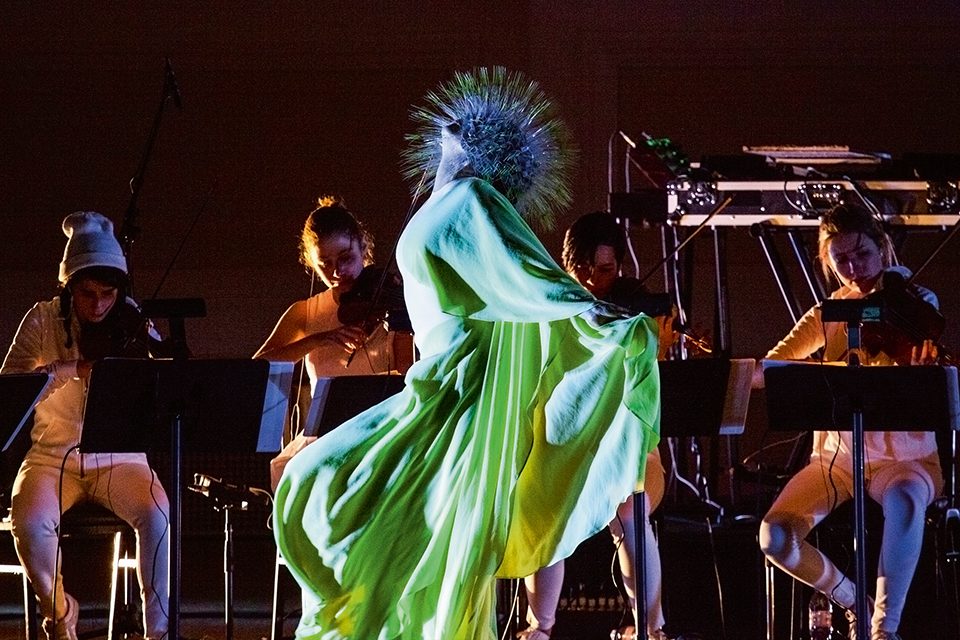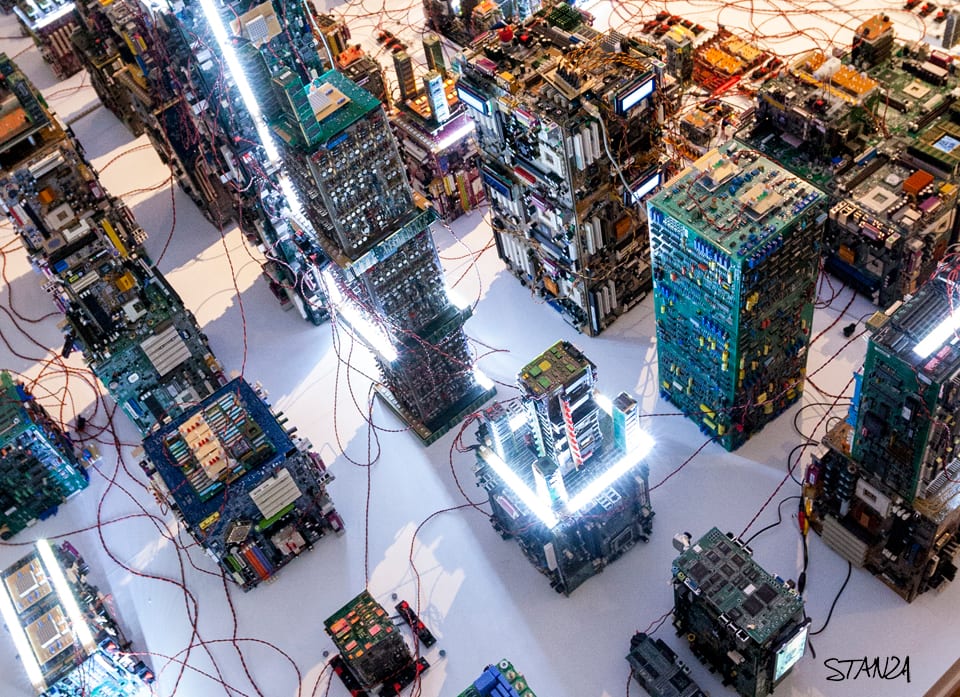Somerset House constructs a brand new world for artistic pioneer Björk, whose quest for audience integration ventures beyond cultural peripheries.
It would be easy to pinpoint Icelandic icon Björk’s commercial heyday in music as the mid-1990s and discuss her now as a digitalised visual artist, but that would be wrong as at the heart of her art is music. With nine full-length albums behind her, and a debut at the age of 11, Björk’s practice is still irrevocably defined by this particular medium. Even her award-winning lead role in Lars von Trier’s Dancer in the Dark (2002) came about because he asked her to write the score.
A desire to connect with the audience, whether through revealing lyrics or through a private recital of Stonemilker VR (a project using the latest in virtual reality that transports each viewer to Iceland for a performance of the first track from Vulnicura), is consistently pursued through culturally up-to-date approaches. This is an artist for whom innovation is the status quo rather than the exception. Björk Digital, at Somerset House, London, sheds light on her electro-video works that span a 24-year career, and the progressions made to enter new, inconceivable theatrical dimensions. Touring on from previous destinations Tokyo and Sydney, the exhibition makes the English capital its base for the European premiere of the show: a one-off performance at the Royal Albert Hall. Les Immatériaux (Centre Georges Pompidou, Paris, 1985) anticipated spectacles such as this: the immersive event encouraged visitors to choose their own path, navigating technological and cultural artefacts through the compulsory headphones and audio guide. Incorporating France’s Minitel system (a rudimentary precursor to the internet) and prototype equipment that was provided by electronics company Philips, the show served to undermine the rigid definitions of what constituted art, design and interactivity. Björk Digital takes its cue from these basic theoretical underpinnings, which critic Kate Linker summarised as a labyrinth of sensory explorations: “Space did not radiate from and return to the spectator who progressed through it, but was divided into zones, their boundaries extended by sound.” The limitations of the current show are only those which the artist herself has set. Taking audience members on a separate journey, the event encourages each individual to question their own cerebral stimulation in a way not provoked by any other musician. Using the 2015 album Vulnicura as a springboard, it constructs a virtual blanket, wrapping its viewers in a panoramic and performative experience. The artist’s recent retrospective at MoMA, New York (2015), centred on her general career, as one would expect, whereas Somerset House showcases purely the new visual pieces.
Despite some rather scathing reviews, it was only the lack of logical curation that was ripped apart. As Guardian critic Jason Farago puts it: “Maybe some time in the future we will get an exhibition that tells the story of how a softly-spoken woman from one of the world’s smallest countries nurtured an entire generation of designers, filmmakers and musicians, and in the process made the boundary between fine art and pop culture meaningless.” Meanwhile, this is a story which London provides one chapter for, showcasing experiments with video, innovative apps, custom-made instruments and, above all, VR, premiered in four separate works: Stonemilker (filmed in 360 degrees); Mouth Mantra (filmed internally in 360 with a specially made camera); Notget (made in VR with a combination of data scanning, game engines and motion capture) and Quicksand (an augmented live VR recording).
Vulnicura is a personal insight into the break-up of Björk’s marriage to the American artist Matthew Barney. Seen as a “heartbreak saga,” and taking its title from the Latin for “cure for wounds,” the album is restlessly experimental. Björk’s manager argues that this is the ethos of her practice: “pop art music at its bravest: when it embraces our day-to-day life and uses the same tools. It would be tempting to escape into a cave and use old tools only, but to her, that doesn’t seem like an option.” The record was not just groundbreaking for its autobiographical content but also for the collaboration with Andrew Huang, using total visual and audio immersion to create an all-encompassing and imaginative environment. An earlier request, Huang’s collaboration on the visuals for Mutual Core (2011), led to its premiere at the Museum of Contemporary Art, Los Angeles. The video, shot in Los Angeles and Iceland, examines the earth’s geology, earthquakes and the forces generated by opposing tectonic plates, translating these forces into a metaphor for those in human relationships: “Opposing forces of compression and release, central to continent building and to human feelings, are expressed sonically in the (Biophilia) app. The shifting of chords in the verses and the visual patterns of the animation were evoked by the working title for this track, organ plaid, a term which describes an interwoven musical fabric.”
The use of new data technologies is consistently becoming the norm for artists such as duo Fernanda Viégas (a computational designer) and Martin Wattenberg (a mathematician and journalist), whose Wind Map (2012) uses interactive software and illustrates the course of winds moving across mainland America. Aesthetically, it appears as a shifting delicate tracing of locks of hair moving across the land mass. Scientifically speaking, the film is a real-time digital illustration of our atmosphere. Both this and Mutual Core show the dramatic shift towards ecology and physical awareness, and technology as a tool to be utilised as an expressive medium as well as a site of discourse about environmental concerns.
Björk’s mastery of art and music sets her apart from her contemporaries. It is attention to technicalities as well as a willingness to try new experimental methods which create these groundbreaking visceral works. Her repertoire covers many different genres including classical, electronica and punk, and is rooted in the work of 20th century German composer Karlheinz Stockhausen, who broke down the perceivable limits of what was musically possible.
Although the Icelandic songstress’s work is tinged by these early musical experiments, she transcends what Stockhausen only dreamt was possible: in effect, she is a modern-day replica, using digital means in order to create visionary aural and electrifying tracks that require the audience’s active engagement. The artist’s manager construes this journey as “being placed by her side as she performs and transforms (in Notget), or being teleported to a windswept beach in Iceland (in Stonemilker), or even inside her mouth … the total absorption of the self through sound and space is key.”
The culmination of all these technological, sound-making and ecological concerns is represented in Biophilia, the app and album created by Björk in 2011, in which her management postulates she uses arpeggios to express bolts of lightning, and chord structures to examine tectonic plates whilst counterpoint represents pendulums and gravity. As part of a larger educational project with the Nordic countries, the software uses ten in-app experiences to explore the relationships between compositions and natural phenomena, or, as developer Scott Snibbe says: “to just enjoy her music.”
The spectacle at Somerset House mirrors the immersive qualities of the hand-held experience, and comprises not just the singular VR processes but also the design and organisation of the exhibition. The installation of Black Lake (the 2015 collaboration with Andrew Huang), for example, features a bespoke, cutting-edge, stereo set-up which provides a full experience of a sound phenomenon. Two large parallel screens are installed to mimic the canyon setting of the video, creating a claustrophobic space that transports the viewer directly into the physicality of the work.
Whilst original in its execution, Björk Digital is but one of a growing number of events taking as its focus the use of new technologies in art and music. For example, the 2014 London Barbican exhibition Digital Revolution paid homage to the games, gadgets and technologies that have shaped the last century as well as the current experiments and designs shaping our future. Whether through the use of lasers to cut and shape intricate 3D forms, as with Eric Standley’s work, or the use of a wall-climbing robot, the Vertwalker (the creation of Julian Adenauer and Michael Haas), which constantly overwrites its own work, we are seeing a new post-modern form that has yet to be defined or categorised.
The extensive video mastery within this fundamental Autumn show, includes collaborations with other leaders in the film and digital fields, taking into account Spike Jonze, Michel Gondry, Nick Knight and Stéphane Sednaoui. Central to these partnerships is the passion to build upon Björk’s song-writing and branch out into not one, but many different and inter-related forms. Since the albums from Björk’s 24- year career are inherently experimental, they ideally lend themselves to this kind of exploration of how the physical manifestation of a final form might develop.
It is easy to lump the work of the Reykjavik-born icon into a “collaborative” attribution, but to do so undermines the core of her entire oeuvre. As a woman, she has seen this practice of group-accreditation before, and continues to see and hear it in relation to her own work. For a female practitioner who grew up in a home where patriarchy was a non-issue, it can be a difficult matter to come to terms with. As she said in an interview with Julia Davis in 2016: “We were in this world where women ruled. And then as I got older I hit these walls, as a woman, or a girl, and I didn’t understand why, because I was just spoilt rotten as a kid; the boundaries weren’t there, you know? It is something I saw in foreign countries.” Once again, her practice is one of diversity and multiple contemplations: she is not just destroying boundaries in the elds of art, music and technology, but equally and as importantly, the expectations of a male-dominated society.
It is a legacy and a phenomenon that continues to evolve within this one-o spectacle at London’s neoclassical cultural centre, merging design, contemporary media, virtual reality and digital advancements within the arts in the hope of deconstructing the limits we set upon ourselves.
Eric Standley explained that with “every efficiency that I gain through technology, the void is immediately filled with the question, ‘Can I make it more complex?’” It is a question that plagues not just Standley but, as we see throughout this massively ground-breaking London exhibition, Björk.
Niamh Coghlan
Björk Digital. Somerset House, London. Until 23 October.





